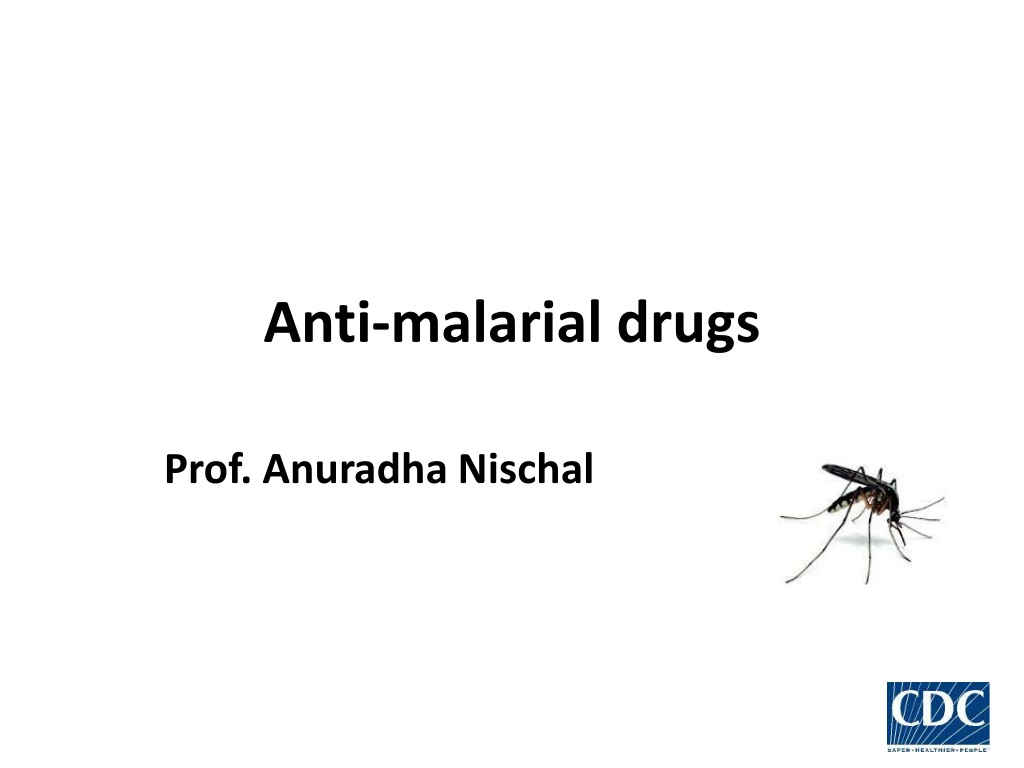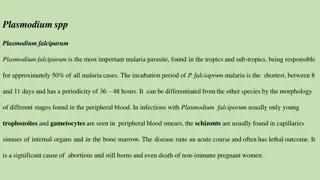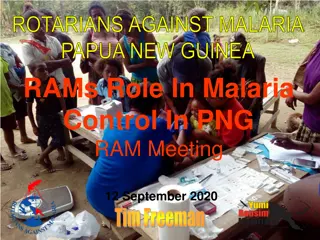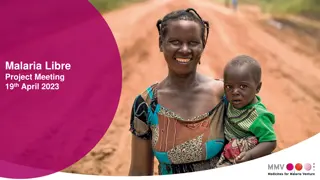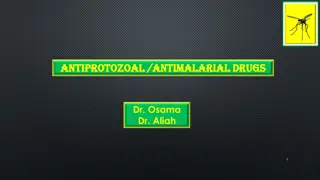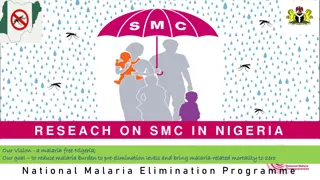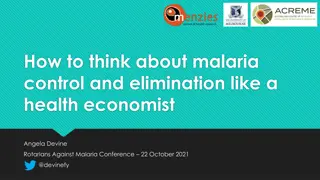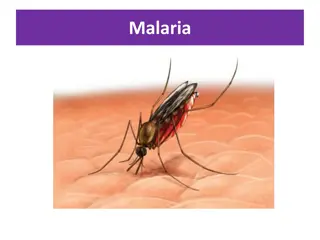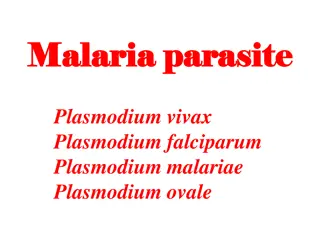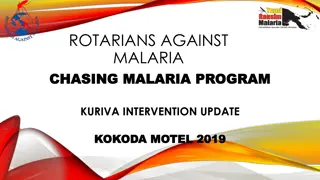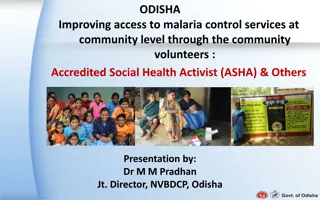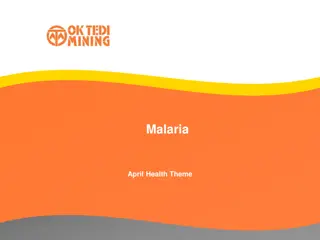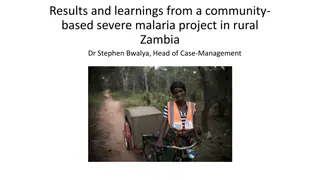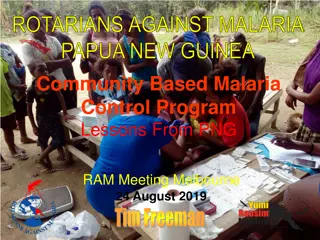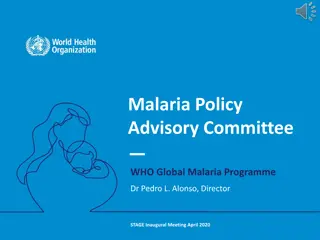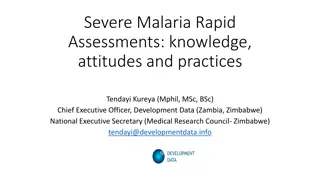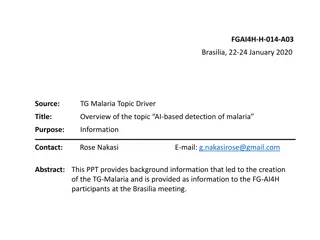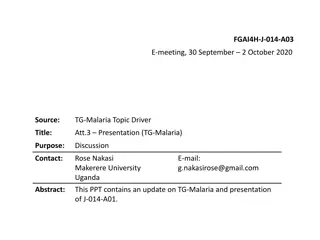Understanding Malaria: Causes, Symptoms, and Treatment
Malaria, caused by the Plasmodium parasite and transmitted through the bite of infected mosquitoes, is a major global health concern leading to millions of illnesses and deaths annually. The life cycle of the parasite involves different stages in the human host and the mosquito vector. Effective anti-malarial drugs are crucial for prophylaxis, treatment, and prevention of relapse. Awareness of the transmission cycle is essential for combatting this deadly disease.
Download Presentation

Please find below an Image/Link to download the presentation.
The content on the website is provided AS IS for your information and personal use only. It may not be sold, licensed, or shared on other websites without obtaining consent from the author. Download presentation by click this link. If you encounter any issues during the download, it is possible that the publisher has removed the file from their server.
E N D
Presentation Transcript
Anti-malarial drugs Prof. Anuradha Nischal
Drugs used for prophylaxis treatment and prevention of relapse of malaria
Malaria Most important parasitic disease of humans, causing hundreds of millions of illnesses and probably over a million deaths each year.
Causative agent Plasmodium 4 species 1) P. vivax (tertian) 2) P. falciparum (tertian) 3) P. ovale (tertian) 4) P. malariae(quartian)
Malaria is transmitted by the bite of infected femaleanopheles mosquitoes. During feeding, mosquitoes inject sporozoites, which circulate to the liver, and rapidly infect hepatocytes, causing asymptomatic liver infection (hepatic phase)(absent in falciparum; malariae) Merozoites released from the liver, rapidly infect erythrocytes to begin the asexual erythrocytic stage of infection that is responsible for human disease Multiplerounds of erythrocytic development, with production of merozoites that invade additional erythrocytes, lead to large numbers of circulating parasites and clinical illness
Release of merozoites subsequent to rupture of erythrocytes causes the clinicalattack of malaria. Some erythrocytic parasites also develop into sexual gametocytes, which are infectious to mosquitoes, allowing completion of the life cycle and infection of others In P vivaxand P ovaleparasites also form dormant liver hypnozoites, which are not killed by most drugs, allowing subsequent relapses of illness after initial elimination of erythrocytic infections
Malaria Transmission Cycle Exo-erythrocytic (hepatic) Cycle: Sporozoites infect liver cells and develop into schizonts, which release merozoites into the blood Sporozoires injected into human host during blood meal Parasites mature in mosquito midgut and migrate to salivary glands Dormant liver stages (hypnozoites) of P. vivax and P. ovale HUMAN MOSQUITO Erythrocytic Cycle: Merozoites infect red blood cells to form schizonts Some merozoites differentiate into male or female gametocyctes Parasite undergoes sexual reproduction in the mosquito
Signs and symptoms Initial manifestation of malaria are non- specific and resembles to flu like symptoms. The presentation includes headache, fever, shivering, arthralgia, myalgia. The paroxysm which includes fever spikes, chills and rigors are classical for malaria
The typical paroxysmal attack comprises of three distinct stages: a) Coldstage- The onset is with lassitude, headache, nausea and chilly sensation followed by rigors. The stage lasts for - 1 hour b) Hotstage- The patient feels burning hot, the skin is hot and dry to touch. Headache is intense. Pulse rate is high. The stage lasts for 2-6 hours c) Sweatingstage- Fever comes down with profuse sweating. The pulse rate gets slower, patient feels relieved. The stage lasts 2-4 hours
These paroxysms have different frequencies in different species of malarial parasites In P. vivax and P. ovale after every 2 days- Tertian fever In P. malariae after every 3 days- Quartan fever While in P. falciparum it recurs in every 36-48 hours These paroxysmal attacks coincide with the release of successive broods of merozites into the blood stream.
Relapse Vs Recrudesence Depending upon the cause , recurrence can be classified either as recrudescence or relapse Recrudescence is when symptoms return after a symptoms free period. It is due to parasites surviving in the blood as a result of inadequate or ineffective treatment. Relapse is when symptoms reappear after the parasites have been eliminated from blood but persist as dormant hypnozites in liver cells. Relapse is common in P.ovale and P.vivax infection Recrudescence is commonly seen in P.falciparum
Classification 1) 4-Aminoquinolines Chloroquine 2) Quinoline methanol Mefloquine Amodiaquine 3) Cinchona alkaloid Quinine Quinidine 4) Biguanides Proguanil (Chloroguanide)
Diaminopyrimidines 8-Aminoquinoline Sulfonamides & sulfone Sulfadoxine Antibiotics Pyrimethamine Primaquine Tafenoquine Sulfamethopyrazine Dapsone Tetracyclins Doxycycline
Sesquiterpine lactones Artesunate Artemether Arteether Halofantrine Lumefantrine Amino alcohols Pyronaridine Naphthyridine Naphthoquinone Atovaquone
Tissue schizonticides That eliminate pre erythrocytic/exo-erythrocytic stages in liver Erythrocytic schizonticides act on erythrocytic parasites Gametocides kill gametocytes in blood and prevent transmission to mosquitoes
Tissue schizonticides Primaquine: 15 mg/kg/day X 2 weeks(hypno) Proguanil Doxycycline Gametocides Primaquine gametocidal for all species. 45 mg single dose Immediately after clinical cure Cuts down transmission to mosquito
Clinical cure Terminate the episode of malarial fever Radical cure eliminate both hepatic and erythrocytic stages Causal prophylaxis Suppressive propylaxis
Clinical Cure Erythrocytic schizonticide is used to terminate the episode of malarial fever High efficacy Low efficacy
High efficacy Low efficacy 1) Artemesinin 2) Chloroquine 3) Amodiaquine 4) Quinine 5) Mefloquine 6) Halofantrine 7) Lumifantrine 8) Atovaquone Proguanil Pyrimethamine Sulfonamides Tetracyclins Clindamycin
Radical cure Eliminates bothhepatic and erythrocytic stages Vivax & ovale Erythrocytic schizonticide + Tissue schizonticide CQ + primaquine
Chloroquine resistance Quinine + Doxycycline/clindamycin + Primaquine Artemesinin based combination therapy + Primaquine
Causal prophylaxis Pre-erythrocytic phase which is the cause of malarial infection and clinical attacks is the target for this purpose Primaquine is the causal prophylactic for all species of malaria
Supressive prophylaxis Schizonticides which suppress the erythrocytic phase and thus attacks of malarial fever can be used as prophylactics Clinical disease does not appear
Supressive prophylaxis CQ: NOT used in INDIA Mefloquine Doxycycline
Supressive prophylaxis Mefloquine 250 mg weekly Starting week before travel & taken till 4 weeks after return from endemic area for CQ resistant P. falciparum
Supressive prophylaxis Doxycycline 100 mg daily Starting day before travel & taken till 4 weeks after return from endemic area for CQ resistant P. falciparum CI in pregnantwomen & children <8years of age
Supressive prophylaxis Pregnancy One dose each in second & third trimester 1 month gap Pyrimethamine(75 mg)+ sulphadoxine(1500mg) In areas with high P.f endemicity
Goal To prevent and treat clinical attack of malaria. To completely eradicate the parasite from the patient's body. To reduce the humanreservoir of infection - cut down transmission to mosquito.
CHLOROQUINE Rapidly acting erythrocytic schizontocide against all species of plasmodia including the senstive strains of P. falciparum Controls most clinical attacks in 1-2 days with disappearance of parasites from peripheral blood in 1-3 days. No effect on Pre-erythrocytic and exo-erythrocytic phases of the parasite does not prevent relapses in vivax and ovale malaria. Only for clinical cure.
Mechanism of action: It is activelyconcentrated by sensitiveintra- erythrocytic plasmodia by accumulating in the acidic vesicles of the parasite and weakly basic nature it raises the vesicular pH and thereby interferes with degradation of haemoglobin by parasiticlysosomes Polymerization of toxic haeme to nontoxic parasite pigment hemozoin is inhibited by formation of chloroquine-heme complex
Haeme itself or its complex with chloroquine then damages the plasmodial membranes. Clumping of pigment and changes in parasite membranes follow: death Other related anti-malarials like amodiaquine quinine, mefloquine, lumefantrine act in an analogous manner
Resistance Reduceduptake and transport of chloroquine to food vacuole of plasmodium.
Pharmacokinetics Oral Widely distributed & concentrated in tissues like liver, spleen, kidney, lungs (several hundred-fold), skin, leucocytes and some other tissues Its selective accumulation in retina is responsible for the oculartoxicity seen with prolonged use
metabolized by liver excreted in urine. The early plasma t1/2varies from 3-10 days. Because of tighttissuebinding, small amounts persist in the body for longer time.
Adverse Effects GI intolerance Nausea, vomiting, abdominal pain, headache, anorexia, malaise, and urticaria are common. Dosing after meals may reduce some adverse effects. The long-term administration of high doses of chloroquine for rheumatologic diseases can result in loss of vision due to retinal damage. Cornealdeposits may occur affect vision: reversible
Contraindications & Cautions Chloroquine can ppt attacks of seizures, psoriasis or porphyria Cautious use Liver damage Severe GI, neurological, retinal & haematological diseases Safe in pregnancy and for young children
Other actions E. histolytica & Giardia lambia Anti-inflammatory Local irritant Local anaesthetic (on injection) Weak smooth muscle relaxant Anti-histaminic Anti-arrythmic properties
Therapeutic Uses Chloroquine is the preferred drug for clinical cure of Vivax Ovale malariae + some sensitivefalciparum strains Causes rapid clearance of fever & Parasitaemia
Extraintestinal amoebiasis/Hepatic amoebiasis/Amoebic Liver Abscess Due to high liver concentrations, it may be used for ameobic abscesses that fail initial therapy with metronidazole. Rheumatoid arthritis Other uses: Discoid lupus erythematosus Lepra reaction Photogenic reactions Infectious mononucleosis
Resistance Resistance to chloroquine is now very common among strains of P falciparumand uncommon but increasing for P vivax. ACT first line for plasmodium falciparum cases countrywide.
Oral Chloroquine phosphate: (250 mg = 150 mg base) Vivax & Ovale: 6oo mg base ; followed after 6-8 hrs by 300 mg; then 300mg daily for two days i.m local tissue toxicity i.v no indication Large intramuscular injections or rapid intravenousinfusions of chloroquine hydrochloride can result in severe hypotension, arrythmias & seizures. Not recommended.
Amodiaquine Identical to chloroquine: mech resistance uses & adverse effects less bitter faster acting than chloroquine. Widely used; reduced cost, safety & activity against chloroquine resistant P. falciparum
Reports of toxicities, including agranulocytosis, and hepatotoxicity (on long term administration), have limited the use of the drug for prophylaxis(Longterm). Not seen with short term use (25-35mg/kg over 3 days) for clinical cure.
Can be used for clinical cure of falciparum malaria with or without CQ resistance X used for prophylaxis Combined formulation with artesunate has been recently approved for use in uncomplicated falciparum malaria irrespective of CQ resistance status preferred in african countries
PRIMAQUINE 8-aminoquinoline Poorerythrocyticschizontocide not useful for acute attack Highly active against gametocytes and hypnozoites
Primary indication Radical cure of relapsing (vivax) malaria & ovale 15 mg/kg/day X 2 weeks(hypnozoites) + CQ/ another bloodschizonticide to eliminate the erythrocytic phase Gametocidal for all species of plasmodia. Cuts transmission to mosquitoes.
Chloroquine Sensitive Falciparum Malaria: Cq + Primaquine A single 45 mg dose (As gametocidal) of primaquine is given with the curative dose of chloroquine to kill the gametes and cut down transmission to mosquito.
